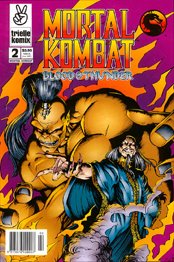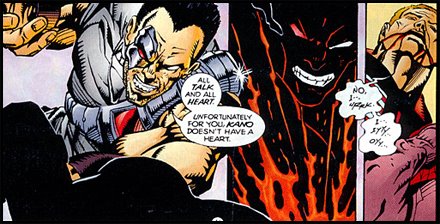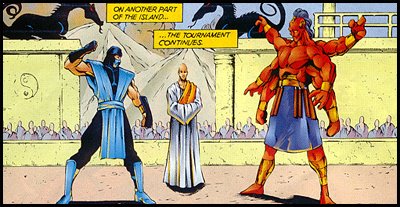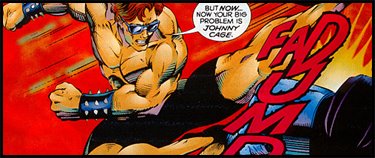 Test Your Might (Malibu/Midway)
Test Your Might (Malibu/Midway)Where: Mortal Kombat: Blood & Thunder #2 When: November 1994 Why: Charles Marshall How: Patrick Rolo
Quick Fix...
If you're an old hat at the Infinite Wars, you know we've got a strong vein of Street Fighter in the Secret Archives. With the announcement of the comic-clashing Mortal Kombat versus DC Universe it was the perfect opportunity to bring America's leading beat 'em up franchise to the Infinite Wars!
Over the past few weeks we've been taking a closer look at the substantial cast of characters that could potentially match-up in the upcoming game [Fantasy Fights R1, R2, R3, R4, R5!]. Also on the agenda have been other features, like last week's megamix review of Blood & Thunder #1, which will all help to paint a fuller picture of the Mortal Kombat/DC universe.
Admittedly, a lot of our discussion has dwelled on documenting the negatives of the Mortal Kombat franchise. It's fair to say this once prominent series has done little to maintain it's respect in an increasingly artistic field, but that's not to say it is without it's charms. For Mortal Kombat, escaping the nineties quaint had to be the driving factor behind an uncharacteristic pause after MK4 in '97/'98.
There's a strong sense of irony surrounding MK and it's crucially dedicated fanbase. Despite the vital creative success of 2002's Deadly Alliance; common consensus amongst fans typically rates 1993's Mortal Kombat II as one of, if not the, greatest game in the series. Though representative of MK's peak significance as a pop culture phenomenon, MKII harkens very specifically back to an era where technological limitations meant many characters were differentiated only by colour and the specifics of four or five custom moves.
This strong nostalgia vote has seen recent recession in MK's creative direction post-Deadly Alliance, doing very little to sway the opinions of critics, or the dismissively uninformed. Sadly, beneath this unimpressive exterior, still lurks the heart of a strong story and potentially significant cast of characters.
Using Malibu's licensed comics as a vehicle to discuss the positives of Mortal Kombat is not easy. It's not at all unfair to say these series represent some of the worst qualities of popular comics of the mid-1990s, and also the worst qualities of the games of the same time. Front and centre, as you might imagine, are the iconic ninja characters from the games.
Colour coded yellow for Scorpion, blue for Sub-Zero, green for Reptile, and grey for Smoke; these iconic characters have never actually had a lot of artistic reason to resemble one and other. In truth, only Scorpion is a ninja among the group that eventually grew to include black Noob, purple Rain, and red Ermac.
Key to the quality of the post-MK4 revolution in the series was a long due overhaul for the individual designs of these series stalwarts. Rare was the opportunity to see story and specific logics influence and dictate the appearance of these characters. Sub-Zero, gradually moving away from the homogenized ninja suit, saw his powers increase naturally, and through the inclusion of a medallion introduced through the series canon.
While it has it's issues, it's arguably the saga of Mortal Kombat that makes this such an engaging series. Sharing much in common with the on-going adventures of superheroes, the MK characters have spent the best part of a decade-and-a-half running their own races of resurrection, revelation, and revenge.
The reveal of franchise icons Sub-Zero and Scorpion in the upcoming MK/DC game has been disappointing. Harkening back to the days of shared sprites, these characters have lost much of the individuality and design that was making them so exciting. No doubt there will be plenty of criticism in the coming months as we hover around the series, but I hope to have more specific positives to share with you at some point. In the mean time; comic book fisticuffs!
- LIEUTENANT LANCE versus KANO
There's something strange about the undertaking of a licensed adaptation. Somewhere in the translation vital elements are lost as writers and artists try to enfuse successful materials with variations and additions of their own design. I do not know why this is such a widespread phenomena, particularly given the long list of infamy that surrounds such a move, but these comics are no exception.
 To the credit of Malibu, their additions aren't without their logics.
To the credit of Malibu, their additions aren't without their logics.For starters, it's always been a little dubious that an elimination tournament would have between eight and ten fighters. In an effort to flesh that out, without killing off the trademarks they've licensed, they introduce guys like Lance.
With one cybernetic arm, Lieutenant Lance looks much less US Special Forces than he does one of the team from C.O.P.S! Fortunately we don't have to deal with him much longer. After joining Sonya in her vehicular pursuit of Kano, it's Lance that steps up to take on the felon in the tournament, reinserting Sonya's classic revenge motiff as a more personalized event for readers.
For those who don't know, it's tradition in games like Mortal Kombat for characters to have some sort of wooden motivation for entering the tournament. For Sonya, the tried and true story of a law enforcement agent seeking revenge for the murder of a partner. In the games that partner was never revealed, allowing us to imagine anyone from Pam Grier, to Jim Kelly, to Van Damme.
The less than impressive extendo-armed Lance does little to enhance this age-old plot, but I suppose an excuse for extra combat in this series is nothing to complain about, no matter how swift.
 Despite getting the drop on Kano initially with an electrical charge, the Lieutenant's destiny is quickly fulfilled with a backhanded swat, and Kano plunging his hand into Lance's chest, only to remove the heart in a splash of blood rare in the comics. Mmm, toasty!
Despite getting the drop on Kano initially with an electrical charge, the Lieutenant's destiny is quickly fulfilled with a backhanded swat, and Kano plunging his hand into Lance's chest, only to remove the heart in a splash of blood rare in the comics. Mmm, toasty!The Fix: 2.5 Winner: Kano (Fatality!)
- SONYA BLADE versus KANO
 None too happy with the death of her partner; Sonya begins her vendetta against Kano quite immediately with blatant disregard for the rules of the tournament!
None too happy with the death of her partner; Sonya begins her vendetta against Kano quite immediately with blatant disregard for the rules of the tournament!Mortal Kombat's always a bit of a misnomer, not only for the apparent immortality of many of it's characters, but also for the nature of combat. Though never really elaborated upon, many of the characters rely on energy attacks, such as Sonya's pink ringed power blast.
It's fair to say much of MK's mythology relies heavily on the conventional logic of martial arts fiction, but in typical MK style, none of this is really explained or detailed, sometimes making the characters look boarish, undisciplined, and severely lacking in the skill department.
One might argue this is a fairly accurate reflection of the fighting quality of the games, but more often than not the fiction asks us to believe they are in fact, master fighters. I digress, but it's all food for thought.
Sonya's energy attack stuns the Black Dragon clansman, leaving him wide open for another trademark attack, the head scissor lock. Sonya vaults the villain head over heels, raising the attentions of Shang Tsung's masked guards.
 Sonya defiantly turns her aggression on the guardsmen, launching into a diving kick that swiftly topples two of the anonymous warriors. Not so cocky, is Sonya, when the four-armed Goro interjects, delighted by her vigor, but intolerant for her impetuousness. The Special Forces agent is led away with her arms bound by the spare hands of the mighty Mortal Kombat champion.
Sonya defiantly turns her aggression on the guardsmen, launching into a diving kick that swiftly topples two of the anonymous warriors. Not so cocky, is Sonya, when the four-armed Goro interjects, delighted by her vigor, but intolerant for her impetuousness. The Special Forces agent is led away with her arms bound by the spare hands of the mighty Mortal Kombat champion.Sonya is arguably one of the most significant female characters in American video game culture. In a strange sort of sexualized way video games managed to make a prominent step forward for female empowerment in fiction. Leading the way were characters like Metroid's deceptively armored Samus; beat 'em up icons like Chun-Li and Sonya; and the once significant, Lara Croft: Tomb Raider.
Inspired by martial arts actress Cynthia Rothrock and baring the name of co-creator Ed Boon's sister; Sonya actually managed to coast through the first MK fairly anonymously. Brought to life through digitized capture of actress Elizabeth Malecki, Sonya set herself apart from genre counterparts Chun-Li and Cammy with the distinction of wearing pants. Despite representing a meagre ten percent of the first game's otherwise all-male cast; Sonya stood out as an early indication of the empowerment of female players in games to come.
No doubt we'll be talking much more about Sonya in the future!
The Fix: 4 Winner: Sonya Blade
- SUB-ZERO versus GRUM
Continuing the trend of ready-made cannon fodder, Malibu serve up another unforgettably ridiculous addition to the series. Grum out-does iconic Mortal Kombat champion, Goro, by bringing yet another additional two arms to the fight! One can only imagine that makes Grum even better than Goro, non?
 No. Not at all.
No. Not at all.Sub-Zero; a character who became a central figure to the story as significant as Liu Kang, or any other hero; gets a chance to shine on his own terms.
Eagle-eyed readers will have noted that links to Sub-Zero thus far are tagged with the name Noob Saibot. Noob was an all black palette swap of Scorpion in 1993's Mortal Kombat II, which also revealed the playable Sub-Zero as brother to the character of the same name, who had actually perished in the first game.
2004's Deception introduced the fact that that first Sub-Zero had been transformed into the dark wraith called Noob Saibot. This concept was soon supported in '05 through the release of the adventure spin-off Mortal Kombat: Shaolin Monks.
The key distinction between the two incarnations of Sub-Zero were the heroic nature of the succeeding brother, and the tie between the former Sub-Zero and his arch-nemesis, Scorpion. The latter version of the character earned the protection of the undead spectre when Scorpion discovered his true identity, leading to further complications later in the tale of his curse.
The Malibu series doesn't quite adhere to the established canon of the video games, allowing the first games' Sub-Zero to survive, and even appear more heroic than his in-game counterpart. X-fans will probably appreciate the parallel between comic book mythology, and the convoluted twists of the MK universe...
 As to the matter at hand; Grum intimidates with six sets of nunchaku spinning wildly, if inconsequentially. Sub-Zero summons the powers of cryomancy to render his opponent inert, leaving Grum helpless before a flying kick.
As to the matter at hand; Grum intimidates with six sets of nunchaku spinning wildly, if inconsequentially. Sub-Zero summons the powers of cryomancy to render his opponent inert, leaving Grum helpless before a flying kick.Goro, having watched the fight, laments on his disappointment in not getting a chance to snap his good friend's neck in battle, settling for Sub-Zero instead.
Sub-Zero is sure to be a prominent representative of Mortal Kombat as we continue to initiate these characters into the Infinite Wars rankings. I hope we might get a chance in the future to take a look at his successor, if only for the opportunity to make a less confusing statement about the identity of each character. Apologies to anyone now irreversably cross-eyed after reading the previous explanation of the two Sub-Zeros.
The Fix: 3 Winner: Sub-Zero (Who eventually becomes Noob Saibot...)
- HYDRO versus JOHNNY CAGE
 Ah! Few characters unique to the Malibu comic series have caused as much confusion and interest as the aptly (but ridiculously) named, Hydro!
Ah! Few characters unique to the Malibu comic series have caused as much confusion and interest as the aptly (but ridiculously) named, Hydro!For those who've grown up with Mortal Kombat as an influence on their vernacular, Sub-Zero is probably so intrinsicly associated with the character, they no longer realise how absurdly descriptive a name it is for a stealthy, bad ass Chinese warrior. In that respect, I feel it's again worth acknowledging precedent for Malibu's ridiculous contribution.
Unfortunately, however, the true status of the character became entangled with rumor, fan distribution, and a healthy dose of vintage arcade-style lying.
The popular practise of MUGEN allows fans to insert, combine, and create playable characters from a wide range of franchise video games. It's here the MK fanbase was able to realise Hydro as a mechanized Lin Kuei cyber-warrior, complete with his own special moves. This, however, only fanned the flames for confusion over whether or not Hydro actually existed.
A quick YouTube search will fill you in on these devices used for fantasy battles between the likes of; Akuma, Homer Simpson, Robocop, and Brolli.
Meanwhile, in the bowels of Shang Tsung's palace... Johnny Cage and Liu Kang seek the Shaolin tandem of Sing and Sang; warriors whose powers combine to make Malibu's most embarassing inclusion -- the green mohawked, Siang!
Whilst navigating the labyrinth of hallways they come across the lurking Lin Kuei warrior, Hydro, who's none too pleased to see them. Hydro shoots first, firing jets of water from his mortal hands in a move reminiscent to Sub-Zero's ice blast!
 Cage is able to duck the move, leaving Liu Kang to glug his way through a face full of water. Cage, smooth customer that he is, takes the opportunity to launch himself into a flying kick that knocks the Lin Kuei warrior into submission.
Cage is able to duck the move, leaving Liu Kang to glug his way through a face full of water. Cage, smooth customer that he is, takes the opportunity to launch himself into a flying kick that knocks the Lin Kuei warrior into submission.Further fisticuffs are quickly quelled by the arrival of the masked guards, who surely keep the secrets of the warriors who have obtained victory, only to disappear from the competition...
The Fix: 3 Winner: Johnny Cage
- KANO versus GORO
The final bout in the series sees Kano return to action.
We've already lamented on Kano's role in luring Sonya to the tournament, but as per the rule of motivation, Kano has his own goals. Never one to pass up an opportunity for crime, Kano enters the tournament with an agenda to liberate certain riches from the veiled sorceror, Shang Tsung.
For Blood & Thunder, this motive grafts onto a theme that will encompass the latter half of the series, and distract from the conventions that justify the entire plot of the game. For you see, despite the zealous enforcement of the masked guards, the rules of combat are quickly dismissed when the Earthrealm warriors wind up bundled into a dungeon beneath Shang Tsung's palace.
 The introduction of a book of riddles; capable of granting the solver power beyond imagination; becomes the omniscient mcguffin that diverts combat to something more akin to the Wacky Racers. Kano brings the book to the A-story when he steals it from behind the back of a fawning Shang Tsung, only to flee to the den of a sleeping Goro.
The introduction of a book of riddles; capable of granting the solver power beyond imagination; becomes the omniscient mcguffin that diverts combat to something more akin to the Wacky Racers. Kano brings the book to the A-story when he steals it from behind the back of a fawning Shang Tsung, only to flee to the den of a sleeping Goro.Goro not surprisingly dispatches the Black Dragon thief with relative ease. An energy blast has little effect on the four armed Shokan, who finishes his opponent with a single backhand, and some dubious dialogue; "I'll have to string you up and finish my business with you later."
Y'know, I always wondered about that ponytail...
The Fix: 2 Winner: Goro (Flawless Victory!)
 The Hammer...
The Hammer...I think, if I had to be honest, a big ol' chunk of self-consciousness is responsible for my continued acknowledgment of Mortal Kombat's issues. I'm very conscious of a split audience in this case, but I assure you all the on-going discussions have been vital not only to my sanity, but to the unfolding events of the Infinite Wars!
As something new(ish) to the site, and topical in nature, it's been providing a great subject to breach relatively easily, and mine lots of discussion from. An important fact because, as you might have noticed, I've been a bit distracted from Infinite Wars duties over the past month.
#2 Noob Saibot (Midway)
#3 Dhalsim (Capcom)
#4 Ken Masters (Capcom)
#5 Johnny Cage (Midway)
#6 Guile (Capcom)
#7 R. Mika (Capcom)
#8 Goro (Midway)
#9 Sagat (Capcom)
#10 Fei Long (Capcom)
#11 Raiden (Midway)
#12 Akuma (Capcom)
#13 Sakura (Capcom)
#14 T. Hawk (Capcom)
#15 Jin Kazama (Namco)
#16 Rose (Capcom)
#17 Sonya (Midway)
#18 Chun-Li (Capcom)
#19 Vega (Capcom)
#20 Birdie (Capcom)
#21 Scorpion (Midway)
#22 Kano (Midway)
#23 Liu Kang (Midway)
#24 Balrog (Capcom)
#25 Sodom (Capcom)As always, I hope this shift in subject can be enlightening and enjoyable for those who log on for more than just our sports league brand of comic fights.
The ranking aspect is always going to be interesting, particularly given the age old debate between Western fanbases surrounding MK and Street Fighter; but there's more at work here. These are characters of archaelogical significance in the pop culture realm, and it feels right to talk more about them, particularly to an audience irrevocably connected, but seemingly disinterested.
As we rocket toward November's Mortal Kombat versus DC Universe I hope we can breach and share some of what's made the series an enduring topic for me. I'm all too aware of MK's problems, but I'm pretty comfortable in the thought that I'm a relatively intelligent fellow and believe I have some credibility in describing the franchise as much more than just 'that fossil of techno syndromed acrobatics masquerading as martial arts'.
This is a franchise populated by characters who've earned their place in the on-going fictional canon. The promotional exercise of the video game seems like the perfect opportunity to remind comics readers of that shared pursuit. It will be a real shame if DC aren't to announce a licensed crossover comic to hit sometime around the game's release, because this is a series so desperately crying out for a decent comics treatment.
The comics creator in me is a little disheartened by the team-up.
Long have I desired the opportunity to tackle these characters in a way they deserve. It was a dream to give these characters the treatment they deserved under the NLT banner, but I'm not too worried.
The deck isn't quite stacked for what I would call a penultimate Mortal Kombat comic, but with competent individuals like Jimmy Palmiotti and Justin Gray involved, it's definitely my hope that we can get some sort of decent project out of this. If there are advantages to be shared for each franchise, replacing the Malibu comics with something more reflective of the strong fiction of the video games seems like a good place to start. We shall be watching!
Fix Average: 3 The Issue: 3.5

2 comments:
Deception was released almost a full year before Shaolin Monks.
Wow! Thanks for picking that up.
I have no idea what happened there. I'll post a correction sometime later...
Post a Comment